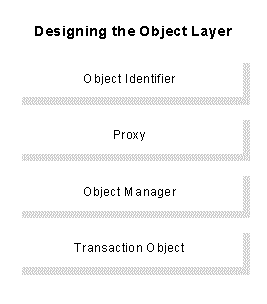Forces Driving the Design of the Object Layer
The main force driving the design of the object layer are features
versus cost: You can come up with many expensive features like complex queries, nested
parallel transactions and so on, but implementing them does not come cheap.
Therefore you will find various product classes with very different comfort and
also very different price tags.
Examples for free, straight forward
solutions: Such solutions will provide you with the basics. You can write an
object to a relational database and retrieve it from there. But you will find no
comfortable ways for queries, no mapping and administration tools and the like.
You can study this class of solutions e.g. in:
 for
Java see YET by Macario Polo Usaola, Mario Piattini, Velthuis, Francisco Ruiz González
(can be downloaded from http://zeus.inf-cr.uclm.es/www/mpolo/yet/); They offer a framework to generate persistent methods in runtime, using
Java's Reflection API. They have a paper on this that has appeared on
the EuroPLoP 2001
pages.
for
Java see YET by Macario Polo Usaola, Mario Piattini, Velthuis, Francisco Ruiz González
(can be downloaded from http://zeus.inf-cr.uclm.es/www/mpolo/yet/); They offer a framework to generate persistent methods in runtime, using
Java's Reflection API. They have a paper on this that has appeared on
the EuroPLoP 2001
pages.
 for
Smalltalk see Joe
Yoder's pages: See his VisualAge implementation of a Persistence Framework for persisting domain objects in a relational
database. Joe collaborated with Quince Wilson on the development of this and
they wrote a pattern language for PLoP '98 proceedings.
for
Smalltalk see Joe
Yoder's pages: See his VisualAge implementation of a Persistence Framework for persisting domain objects in a relational
database. Joe collaborated with Quince Wilson on the development of this and
they wrote a pattern language for PLoP '98 proceedings.
Examples for comfort products: Such
products offer your o-o language an interface that looks almost like the
interface of an OODB for that language and they will also offer administration
tools for the database. You can study this class of solutions e.g. at:
 for
Java and comfort see various products,
some of which are are also available open source
for
Java and comfort see various products,
some of which are are also available open source
The collection of patterns to follow is
not a complete collection of all possible patterns for the object layers.
Instead it is a collection of important ones that have been mined already.
What's missing is stuff on queries, handling object relations, iterators for 1:n
relations at the language interface level and more. For a standard on how all
this should look like for a user of an o/r mapper in maximum comfort, take a
look at the actual ODMG
standard.
Local Roadmap

Figure 8: Local Roadmap for Designing the Object Layer
Pattern List
The patterns you need to construct the object layer have all been
described in other papers.
- Object Identifier
: How do you represent an object's individuality in a relational
database? See [Bro+96]. Some would doubt today that this is a
pattern. The concept is described very clearly in The Object-Oriented Database System
Manifesto [Atk+89], which gives a definition of Object
Identity in the context of object-oriented databases. The same definition is applicable
for object/relational access layers.
-
Proxy: How do you prevent all related objects to be loaded whenever you touch one
object that has relations to many others? See [GOF95], the
unofficial version of "Crossing Chasms" [Bro+96] and
also Scott Meyers on Smart Pointers [Mey96]. See also the
Reference class in [Hei98, Section 7.5].
- Object Manager
: How do you preserve
object identity? See the View Cache
pattern in [Kel+98a], or the Object
Manager in [You+95, pages 291-292, Max96] plus the
unofficial version of "Crossing Chasms" [Bro+96]. To
understand the interactions between the Object Manager, Transaction Objects
and the objects of the object/relational access layer, replacing the term Object Manager
with View Cache, and the term object with
Logical
View.
- Transaction Object
: How do you handle transactions at a user code level? For a
solution see the pattern in Accessing Relational Databases [Kel+97] which was in fact adapted from what we
saw in object/relational access layers and the ODMG standard [ODMG93]
or see [Hei98, Chapter 10]
- Database Object Protocol
: How do you provide a uniform protocol for all your
persistent objects? You derive them from a DatabaseObject. This is an application of
abstract base classes.
- Narrow Views
and
Short Views [Kel+98a]: are two patterns that should be
considered, when designing the ad hoc query capabilities of your access
layer.
- Basic Relationship Patterns
[Nob97]
plus the ODMG-Standard [ODMG93] show you how to implement object
relationships. Mapping interobject relationships to relational databases is treated in Mapping
Objects to Tables.
-> on to the Tuple Layer
-> up to the Contents Page
![]() for
Java see YET by Macario Polo Usaola, Mario Piattini, Velthuis, Francisco Ruiz González
(can be downloaded from http://zeus.inf-cr.uclm.es/www/mpolo/yet/); They offer a framework to generate persistent methods in runtime, using
Java's Reflection API. They have a paper on this that has appeared on
the EuroPLoP 2001
pages.
for
Java see YET by Macario Polo Usaola, Mario Piattini, Velthuis, Francisco Ruiz González
(can be downloaded from http://zeus.inf-cr.uclm.es/www/mpolo/yet/); They offer a framework to generate persistent methods in runtime, using
Java's Reflection API. They have a paper on this that has appeared on
the EuroPLoP 2001
pages.![]() for
Smalltalk see Joe
Yoder's pages: See his VisualAge implementation of a Persistence Framework for persisting domain objects in a relational
database. Joe collaborated with Quince Wilson on the development of this and
they wrote a pattern language for PLoP '98 proceedings.
for
Smalltalk see Joe
Yoder's pages: See his VisualAge implementation of a Persistence Framework for persisting domain objects in a relational
database. Joe collaborated with Quince Wilson on the development of this and
they wrote a pattern language for PLoP '98 proceedings. 